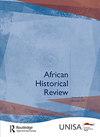The Bantustan State and the South African Transition: Militarisation, Patrimonialism and the Collapse of the Ciskei Regime, 1986–1994
IF 0.1
Q3 HISTORY
引用次数: 1
Abstract
Abstract This article examines the Ciskei bantustan and processes of state formation during the transition to democracy. In the Ciskei, the rule of Brigadier Oupa Gqozo rested on the continued support of the South African state: identified as the weakest link in the National Party's conservative alliance, the Ciskei became the first target for the African National Congress's mass action campaign of 1992. The struggle in the Ciskei thus had some significance for the shape of the transition. While at a constitutional level the National Party eventually conceded to the reincorporation of the bantustans in late 1992, it continued to stall change and to bolster the bantustans through covert military operations and land transfers to bantustan elites. These dynamics of state formation are critical aspects of the history of the transition and were at the heart of the emerging political conflict in the Ciskei, which by mid-1992 was escalating into civil war. This article examines mass mobilisation, political repression and the consequences of the patrimonial militarisation of the Ciskei state in the Ciskei/Border region. By focusing on processes of state formation and struggles over the fabric of the state, the article provides a corrective to the prevailing academic focus on the elite negotiations and argues for the value of social histories of the bantustan states for understanding the enduring legacies of these regimes.班图斯坦国家和南非转型:军事化、世袭主义和西斯凯政权的崩溃,1986-1994
摘要本文考察了向民主过渡期间的国家形成过程。在西斯凯,Oupa Gqozo准将的统治取决于南非国家的持续支持:西斯凯被认为是国家党保守联盟中最薄弱的一环,成为1992年非洲人国民大会大规模行动的第一个目标。因此,西斯基的斗争对过渡的形成具有一定的意义。虽然在宪法层面上,国家党最终在1992年末承认了班图斯坦人的重组,但它继续拖延变革,并通过秘密军事行动和向班图斯坦精英转让土地来支持班图斯坦。这些国家形成的动态是过渡历史的关键方面,也是西斯凯地区新出现的政治冲突的核心,到1992年年中,这场冲突升级为内战。这篇文章探讨了大规模动员、政治镇压以及西斯凯州/边境地区世袭军事化的后果。通过关注国家形成的过程和对国家结构的斗争,文章纠正了学术界对精英谈判的普遍关注,并论证了班图斯坦国家社会历史对理解这些政权的持久遗产的价值。
本文章由计算机程序翻译,如有差异,请以英文原文为准。
求助全文
约1分钟内获得全文
求助全文

 求助内容:
求助内容: 应助结果提醒方式:
应助结果提醒方式:


